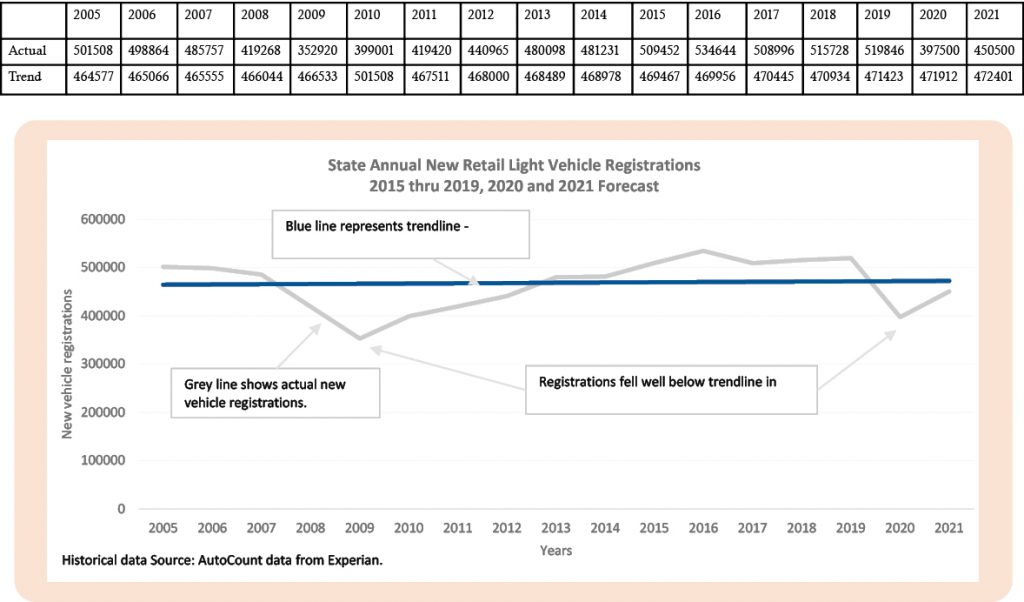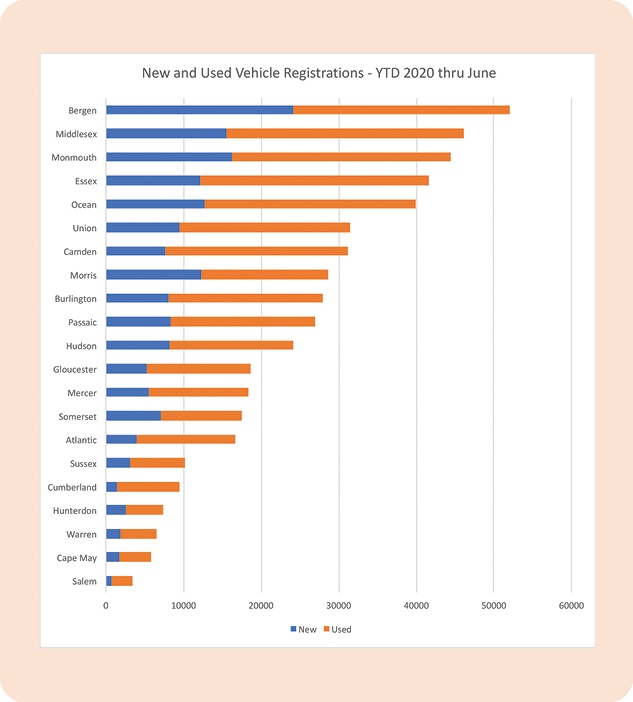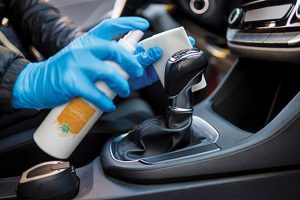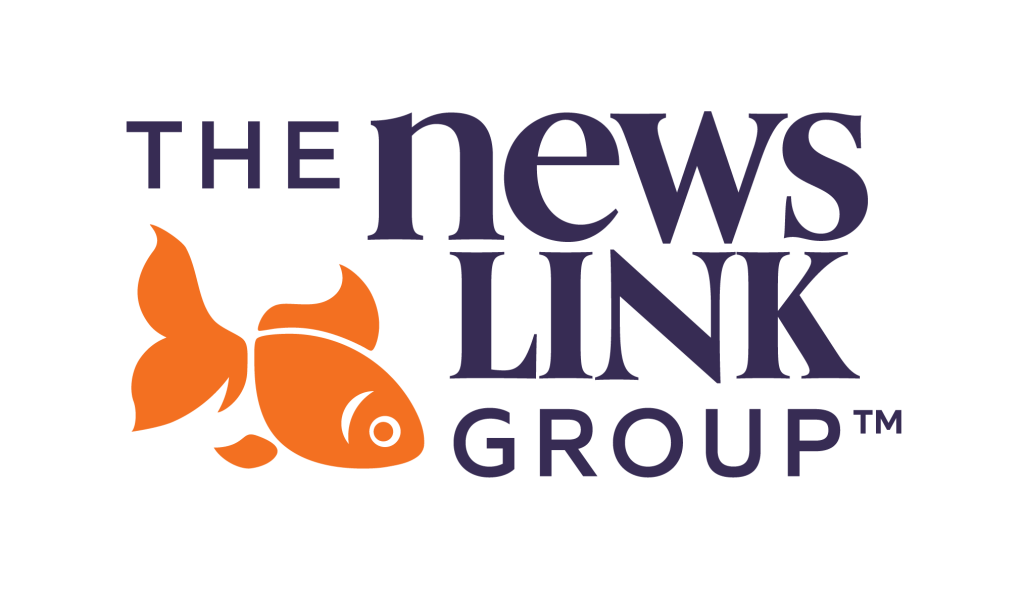By Jeff Foltz
The New Jersey new vehicle market got off to a good start in the first two months of this year, and then the bottom fell out when the COVID-19 crisis took hold in March. New vehicle registrations in the state declined 32.3% during the first six months of 2020, versus a year earlier, and tumbled by 53.1% in the Second Quarter alone. But all of that is now in the rear-view mirror. At this point, attention is squarely focused on what lies ahead.
According to Auto Outlook’s most recent forecast, new retail light-vehicle registrations in the state are predicted to fall by 15% in the second half of 2020 versus a year earlier. The decline is not welcome news, but it is a marked improvement from the 32.3% fall in the first half of 2020. New vehicle registrations for all of 2020 are expected to approach 400,000 units, down from 519,846 in 2019. The outlook is better for 2021. New registrations in the state are projected to approach 450,000 units next year, an increase of about 13% from 2020.
There is a lot of uncertainty attached to these projections. Right now, the forecast estimation process is about as complicated as it gets. Here are the basic steps: gather evidence from experts on the likely course of a never-before-seen virus, figure out the implications for business operations, sort out the consequences for employment and economic growth, and finally, pinpoint the volume of new vehicle sales. It’s a fuzzy chain, and the uncertainty grows with each link. But since the pandemic hit in mid-March, enough clues have emerged to explain where the market has been, and more importantly, pinpoint what lies ahead.
Here are four general phases that are likely to characterize the pattern of new vehicle sales throughout the COVID crisis, starting with when the crisis hit in early March, and stretching into later phases of the recovery, that could extend for more than two years.
The first phase began when the state felt the full brunt of the pandemic in March — businesses closed, dealership operations were curtailed, and new vehicle sales collapsed. The second phase took place when re-openings occurred. New vehicle sales got a short term boost from the release of some pent up demand (partially resulting from lease turn-ins that were postponed), resilient household incomes (supported by unemployment compensation benefits and stimulus checks), and the advancement of online/remote sales.
In the third phase, sales softened as initial pent-up demand was released, new vehicle inventories were tight, restrictions on business operations were lifted slowly (or in some cases, reversed), stimulus programs were dialed back, and consumer sentiment was impacted by concerns related to how long the pandemic could last and consequences for employment and income. This is where the market is now.
The fourth phase will likely occur over an extended period, perhaps lasting for more than two years. The overall sales trend is gradually upward, but the market will be subject to periods of ups and downs due to possible surges in the virus and any business shutdowns. The economic shock has been significant, and it will likely take years for a full rebound. Employment in the state was 13% lower in June of this year than it was a year earlier, and the unemployment rate exceeded 15% in the second quarter. Business operations have been severely interrupted, and barring a dramatic advancement in the release of vaccines or treatments for the virus, the return to full employment will not happen quickly.
So the recovery will likely be gradual and subject to ups and downs, but as mentioned above, the overall trend should be positive. Here are the three primary factors that will provide support to the market for the foreseeable future.
Vehicle affordability is improving. The Federal Reserve has practically guaranteed that interest rates will be near zero for at least two years. In addition, the manufacturers have the ability to open the incentives spigot when needed.

Pent up demand is rising. Sales are likely to be 20% below anticipated pre-crisis levels in 2020. Vehicles wear out, leases expire, and the technology gap between new vehicles and the average 10-year-old car on the road widens. The accompanying graph shows the actual new retail light-vehicle registrations in New Jersey between 2005 and 2019, and Auto Outlook’s forecast for 2020 and 2021. The graph also shows the long term trendline, which is primarily a function of the driving-age population. Actual registrations typically move above and below the baseline due to changing economic conditions. Of course, in 2020, the shift below baseline occurred due to the pandemic. Auto Outlook estimates that approximately 63,000 new vehicle purchases are likely to be postponed in the state by the end of 2021, but they will eventually occur.
Sales will get a boost by changes in behavior caused by the virus. People are reluctant to board a plane, get on a train or take a shared ride. Using your own vehicle is the best safe haven from the risks inherent in other modes of transportation. When the threat from the virus wanes, some will return to planes, trains, and shared rides, but the advantages of having your own vehicle will remain. Vehicle ownership provides freedom, independence, and a sense of personal control. These benefits are garnering more attention right now, and should still impact consumer behavior, even when COVID-19 fades.

Wrap up: The chances of a fast recovery seem slim, but there is more “upside potential” for the outlook than downside. The likelihood that the economic slump will significantly worsen is low. The introduction of a vaccine or highly effective treatment for the virus would significantly increase the slope of the upward trend and decrease the frequency of the stops and starts.
Jeff Foltz is President of Auto Outlook, Inc., an independent automotive market research firm. He can be reached at autooutlook@me.com.
This story appears in Issue 2 2020-21 of the New Jersey Auto Retailer Magazine.









